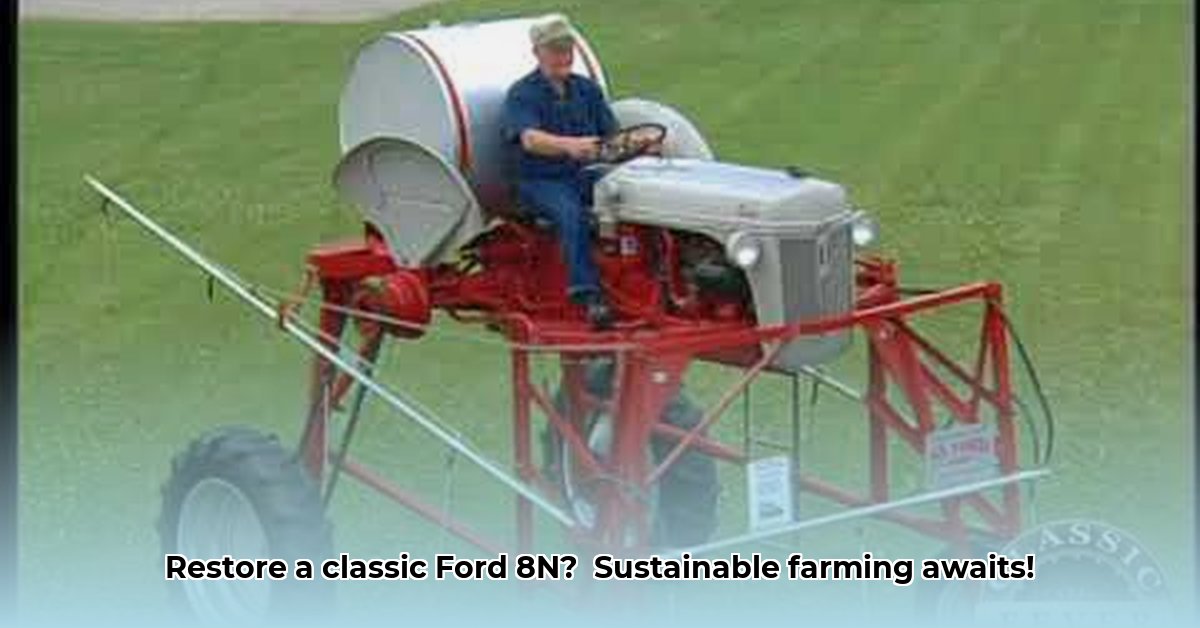
Part 1: The 1949 Ford 8N Tractor – A Timeless Workhorse for Modern Sustainable Farming
The 1949 Ford 8N tractor isn't just a piece of history; it's a surprisingly relevant tool for today's sustainable farmer. Its simple design makes maintenance straightforward and accessible, a critical advantage when resources are limited. Furthermore, the abundance of readily available parts minimizes downtime and repair costs, unlike modern tractors with complex systems and often scarce, expensive parts. Isn't this a refreshing approach to farming efficiency? For more information on Ford 8N parts, check out this helpful resource.
While the 8N's horsepower is lower than modern counterparts, this isn't always a drawback for small-scale farming. For many homesteaders, a smaller, more manageable tractor is ideal for tasks like tilling small plots and light hauling. Its lower power also translates to less fuel consumption and reduced emissions, supporting eco-friendly agricultural practices—a significant win for sustainable farming.
Part 2: Restoring Your 1949 Ford 8N: A Practical Step-by-Step Guide
Restoring a vintage tractor is a rewarding experience that blends mechanical skill with historical appreciation. The process is manageable when divided into distinct phases.
1. Initial Assessment: Begin with a thorough visual inspection. Photograph everything, noting the condition of each component—engine, transmission, hydraulics, etc. This detailed record is invaluable for tracking progress and sourcing parts.
2. Parts Acquisition: Sourcing parts is easier than you might think. Online forums dedicated to Ford 8Ns are excellent resources for connecting with experienced enthusiasts and locating suppliers of both original and replacement parts.
3. Engine Overhaul (If Necessary): The engine is the core of your tractor, and professional help might be wise here. A proper engine overhaul ensures both performance and longevity, which are essential for long-term sustainability. Considering engaging a skilled mechanic will save time and potential frustration.
4. Mechanical Systems Restoration: Once the engine is functioning, focus on the transmission, brakes, steering, and other mechanical systems. Replace or repair any worn or damaged components – reliability is paramount for safety.
5. Safety Prioritization: Before starting the engine, conduct a comprehensive safety check. Ensure the condition of brakes, lights, and steering components, which are crucial for safe operation.
6. Initial Engine Start-up: After assembling, start the engine and carefully test all systems, making necessary adjustments.
Part 3: Integrating Your Restored Ford 8N into Sustainable Farming Practices
Your restored 8N is ready to support your sustainable farming goals.
- Task Matching: This tractor excels at smaller-scale tasks: tilling small plots, light hauling, and operating implements designed for its three-point hitch. Its compact and lighter design minimizes soil compaction.
- Sustainable Fuels: Consider using biodiesel blends or other renewable fuels wherever possible to reduce your carbon footprint and support environmentally friendly farming.
- Cost-Effectiveness Analysis: Compare the running costs (fuel, parts, maintenance) of your 8N to modern compact tractors. Often, the simplicity of the 8N translates into lower long-term costs, especially for smaller operations. The initial acquisition cost is significantly lower.
Part 4: Community and Resources: You're Not Alone
Online communities dedicated to Ford 8N tractors offer invaluable support and resources.
- Online Forums: Engage with fellow enthusiasts to glean advice, share experiences, and locate parts.
- Specialty Parts Suppliers: Utilize specialized suppliers providing parts specifically for Ford 8Ns.
- Local Expertise: When needed, consult local mechanics specializing in vintage farm equipment.
Weighing the Pros and Cons of the 1949 Ford 8N Tractor
| Pros | Cons |
|---|---|
| Lower initial purchase price | Lower horsepower than modern tractors |
| Simple design, easier maintenance | Requires mechanical skills or professional help |
| Readily available parts | Slower working speed than modern models |
| Potential for reduced running costs | May not suit all farming tasks |
| Reduced potential environmental impact | Older technology, fewer advanced features |
| Personal satisfaction of restoration | Requires time and patience for restoration |
The 1949 Ford 8N, while not cutting-edge, offers a blend of historical charm, practical utility, and surprising relevance for the modern sustainable farmer. It's a cost-effective and environmentally conscious solution for many small-scale operations. While not a universal solution, for the right farmer, it represents a valuable and sustainable choice.